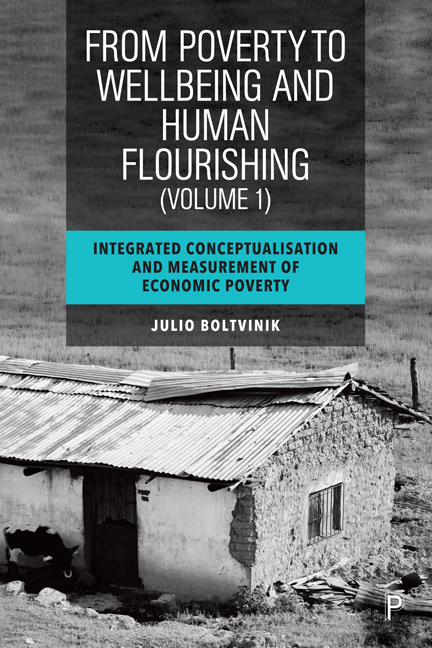 From Poverty to Well-Being and Human Flourishing
From Poverty to Well-Being and Human Flourishing 8 - The Integrated Poverty Measurement Method (IPMM)
Published online by Cambridge University Press: 28 March 2024
Summary
8.1 The genesis of the IPMM
In 1987 I presented a lengthy report on poverty in Mexico to UNDP Latin America. The report had been prepared by a small team of consultants that I headed and was well received at the headquarters of the Regional Project for Overcoming Poverty. As a result, I was soon hired. Shortly after that, the new head of the Mexican team, Antonio Suárez McAuliffe, wrote a comment severely criticising the structure of the report, particularly the lack of integration between the measurement of Y poverty (or PL method) and the parallel description of the levels and evolution of deprivation regarding some basic N. He was absolutely right. I had followed COPLAMAR’s procedure and thus replicated its fragmentary and disintegrated character. My receptivity to this criticism changed my view of poverty. A few months later, I had the good fortune of coming across the research results by Beccaria and Minujin (1987) and Kaztman (1989), referring to Buenos Aires and Montevideo, respectively. These authors had been experimenting with the contrasts between the populations identified as poor by the two PMM applied at the time in South America: Y poverty (PL) and UBN, which were conceived as alternative methods. In its Latin American variants (that I call original or restricted, because of the very few indicators used), UBN conceives a HH as poor if it is poor (deprived) in one or more indicators, as described and appraised in Chapter 6. Both research papers looked simultaneously at UBN and PL, formulating a contingency matrix similar to the one presented in Table 8.1.
Neither Beccaria-Minujin nor Kaztman realised that they were witnessing the birth of a new PMM. However, my awareness had been sharpened by Suárez McAuliffe’s critique, and I discovered that by adding a P criterion to these contingency matrices, a new method would ensue. This method, which I called the Integrated Poverty Measurement Method (IPMM), conceives PL and UBN not as alternative but as complementary PMM. The poverty criterion adopted defined the poor population as the union of both sets of poor, that is, the three italicised cells in the matrix: the poor by PL and by UBN separately (13.5% and 16.5% respectively) and the intersection of both (40.7%), totalling 70.7% (Boltvinik, 1990a).
- Type
- Chapter
- Information
- From Poverty to Well-Being and Human FlourishingIntegrated Conceptualisation and Measurement of Economic Poverty, pp. 141 - 187Publisher: Bristol University PressPrint publication year: 2023


